Abstract
Workplace location has a significant impact on daily mobility behavior, such as mode of transportation choice, as well as long-term decisions such as car ownership and residential location choice. Therefore, understanding accessibility to workplaces is crucial for promoting sustainable mobility. However, there is currently a lack of comprehensive, open-source methodologies for multimodal and intermodal accessibility modeling for workplace locations. In this study, we present a modeling concept based on open-source tools such as OpenTripPlanner, PostGIS, and R, which allows for efficient and fast accessibility analysis of workplace locations at a regional level. Using the Munich Metropolitan Region as a case study, we demonstrate the feasibility of our model in conducting large-scale, multimodal, and intermodal accessibility analysis on consumer hardware. The maps produced by our model provide both absolute and relative indicators of accessibility, such as public transportation versus car accessibility, as well as a score. The results show that Munich and other centers have high competitiveness for non-car modes and intermodal combinations, but smaller cities also have potential for workplace locations that are not reliant on car access, with a large number of potential workers able to reach these locations within 30 min without driving.
1. Introduction
The location of our workplace, where we spend a significant portion of our lives, has a significant impact on the daily routines of the global working population. The commute to work is a constant feature of our daily schedules and can either be a burden or an opportunity to relax or focus. Research indicates that for many individuals, the location of their workplace and the mode of transportation they use to get there are significant factors that shape their daily lives [1,2,3,4]. The location of the workplace is associated with the daily mobility behavior (e.g., mode choice), long-term mobility decisions (e.g., car ownership, annual transit passes), and also residential location choice [5]. Many case studies and reviews in the literature [6,7,8,9] have observed these significant effects of the workplace location on its workers, and this effect can even be more formative than the effect of the residential locations [8,10]. In the Munich Metropolitan Region, it was shown recently [8] that the relocation of workers to workplaces with a lower accessibility is associated with the uptake of car commuting and increases in car ownership. Vice versa, it was observed that a workplace relocation to a location with higher centrality is associated with a modal shift towards public transport, whereas car ownership is not decreasing [8]. This emphasizes the workplaces’ role as a potential trigger for increasing car availability and the subsequent uptake of driving for many trip purposes. Thus, there is both a potential and a risk for planners when we aim for planning workplaces that foster sustainable mobility and avoid car dependence, as outlined by regions and cities. Thereby, it is neither sufficient to look at these locations only from a land-use perspective nor from a mobility perspective. Both the structural properties of the surrounding region, e.g., in terms of settlement structures for housing, but also the mobility networks that connect the workplace to the potential workers are of high importance for the assessment of a location.
For this integrated analysis of land use and transport, the concept of spatial accessibility, as first introduced by Hansen [11] and defined in different ways, e.g., [12,13,14,15,16], is a suitable approach. Accessibility analysis has been widely used for various types of analysis [12,17], and countless approaches to operationalize it have been developed (for an overview, see [18,19,20,21,22]).
A recent review by Siddiq and Taylor [22] looked at 54 accessibility metrics. Adding up to previous reviews [12,19,23,24,25,26], they classified them in terms of theoretical basis, data requirements, units of analysis, travel modes, and trip purposes. They acknowledge and categorize a wide range of tools and metrics, with the main categories being place-based and people-based tools. While the former look at the accessibility of places (such as workplaces, often aggregated in zones), the latter look at individual persons (or households) with their respective attributes. In line with other authors, they describe that while research advances theories and measures with a high pace, the application in practice still lags. Using interviews with practitioners, they explain that tools are either too complex or too in-transparent (“black box”) for practitioners to be used in their work. Results are often too difficult to understand and to explain, in their opinion. Moreover, practitioners state that there is a lack of expertise in their institution when it comes to applying existing tools and methods. Further, intense data collection and data processing efforts are a burden for the implementation of accessibility measures.
However, they argue that a new generation of tools makes it easier for practitioners to include accessibility analysis in their work—if these accessibility tools are meaningful, do not have overly complex data requirements, and are easy to be communicated and understood by practitioners.
Especially in the German context, few to no standardized, established accessibility measures that fulfill these criteria are used in planning practice [19,20,27].
In general, however, the development and availability of geographic information systems (GIS) such as ArcGIS (commercial) and QGIS (open source) as well as other geospatial tools and packages has greatly improved the ability of researchers and planners to run various kinds of accessibility analyses [28]. In combination with an increase in openly available data, such as OpenStreetMap, but also public transport networks in GTFS format [23,29], the potential for accessibility analysis is now greater than ever.
Pajares et al. [29], for example, focus on open-source accessibility modelling for active mobility. They also emphasize the still-existing implementation gap between science and practice while highlighting the emergence of successful open-source approaches such as QGIS and OpenTripPlanner (OTP), empowered by the increasing availability of open data sources.
For accessibility models that are capable of modelling public transport, Malekzadeh and Chung [23] reviewed the state of the art. They distinguish three approaches for measuring public transport accessibility: The first approach deals with “physical access to the public transit network”, measuring the ability to reach public transport stops with different modes of transport. This dimension can usually be modelled with tools developed for active mobility, since access and egress modes are often non-motorized. The second dimension “system-facilitated accessibility” describes the “traveler’s ability to reach an opportunity by incorporating the travel time or cost spent in the transit network”, including first- and last-mile trip legs by walking. This already requires some sort of public transport routing algorithm. The third dimension “access to destinations” measures the ability of individuals to reach multiple opportunities within the network, using potentially many different routes in the public transport network. Therefore, a high-performance routing tool is necessary, and usually, simple travel time queries to interfaces of commercial services do not suffice. Similar to Pajares et al. [29], they conclude that the availability of open data, especially public transport network information in GTFS format, is an important achievement in order to model public transport accessibility in a realistic way, taking into account the variations in the network.
There are many examples for operational accessibility models that are generally suitable for the accessibility analysis of workplace locations: Commercial software packages such as the geographic information system ArcGIS Pro [30] or the transport modelling software PTV VISUM are capable of calculation fundamental accessibility analysis, e.g., [31], such as contour measures or gravity-based indicators. These tools are frequently used by researchers and practitioners to calculate accessibility [32]. The major disadvantage, however, is the high cost of obtaining a license for these commercial products.
Recently, new tools have been emerging, with a trend to publish algorithms and tools as open-source code. Well-known examples for this are OpenTripPlanner [33] and the r5 routing engine, developed by Conveyal [34] and based on methods presented in [35,36,37]. The use of both tools has been facilitated by R packages that ‘wrap’ the functionalities of the routing engines into comfortable R packages, namely, opentripplanner [38] and r5r [39]. Both sets of tools, commercial and open-source, were tested and compared in depth by Higgins et al. [30]. The authors found all tools suitable in general for place-based accessibility calculations based on OD matrices. ArcGIS’ network analyst was found to have an in-transparent ‘black-box’ algorithm for public transport travel time calculations. R5r was capable of the fastest OD matrix calculations while OpenTripPlanner was capable of using realistic travel behavior for its calculations, e.g., through including weights for transfers. In conclusion, the authors emphasize that each tool produced different travel time results for the study area. They also warn of a risk of algorithmic dependence for travel times, which can impact the accessibility results. Another problem, especially with open-source tools, is the dependence on data quality in OpenStreetMap.
On the basis of the literature, there is no conclusion on how to model accessibility in the context of workplace locations. Thus, it is our contribution to propose an open-source methodology to advance the capabilities of researchers, municipalities, and companies to better understand the accessibility of workplace locations in order to derive recommendations for policy and practice in a subsequent step.
For a holistic and useful accessibility assessment of workplaces, we define the following criteria for a suitable assessment method:
- All relevant modes of transport need to be included (multimodal perspective): In Germany, these are walking, public transport, cycling, and driving [40].
- For results that better reflect the real-world travel choices of commuters, combinations of these modes (intermodal perspective) should be included as well. Especially the bicycle, as an emission-free, space-efficient mode to access or egress rail-based public transport, is of particular interest for current policies in the region [41] and beyond [42].
- All analysis should be conducted using real timetable-based travel times in public transport so that the particular conditions of commuting are reflected in the model (e.g., higher frequencies during the morning peak hour).
- The methodology should be fully adjustable so that both changes in the land-use component as well as in the mobility supply can be included, e.g., in the form of scenarios. This includes new housing, new public transport lines, changes in timetables, and new cycling infrastructure, among others.
- To create a universally applicable and transferable methodology, it should be based on open-source tools. This avoids black boxes in the methodology and maximizes the potential impact, since no license fees are necessary to apply the method. Moreover, an open-source methodology makes the modelling process transparent and replicable.
- In order to make the methodology useful for practical applications, the calculation time for a grid-based analysis of a functional urban area should be below 12 h in order to allow relatively fast scenario comparisons.
- In line with [43] and on the basis of the proclamations by [17], these requirements support that the assessment method will find a good balance between accuracy/detailedness on the one hand and transparency and simplicity on the other.
The first goal of this paper is thus the development of a methodology that allows for the measurement and evaluation of the accessibility of workplace locations throughout a region with the help of open-source tools, with the aim of making better informed decisions about workplace locations with good multimodal and intermodal accessibility. The second goal is then to test this this methodology by applying it to the region of Munich in order to better understand the implications of the modeling results, as well as strengths and weaknesses of the methodology. Thus, the research questions can be defined as follows:
- How can multimodal and intermodal accessibility measures for workplace locations be operationalized on the basis of open-source tools and open data?
- What do we learn from the application of a region-wide analysis of workplace accessibility?
On the basis of these questions, we formulated the research hypothesis: A multimodal and intermodal accessibility model for workplace locations will be a useful planning support instrument for assessing the capability of the integrated land-use and transport system to enable potential workers to access the workplace location within a given time budget with a selected set of travel modes.
2. Methodology
2.1. Modeling Concept
Our proposed accessibility model “EMMA—Empowering multimodal and intermodal accessibility analysis for workplace locations” consists of three main components:
- OpenTripPlanner is used to calculate isochrones (see [33] for an introduction);
- A PostGIS database is used to store spatial data (permanently and temporarily) and perform spatial queries;
- A script (written in R) is used to steer and automate the process.
The working principle is visualized in Figure 1. In contrast to existing models, this approach does not calculate an OD matrix for all cells. Instead, this approach calculates one isochrone per grid cell, which is then used to calculate the number of people who can reach the hexagon grid cell (=the workplace location) directly.
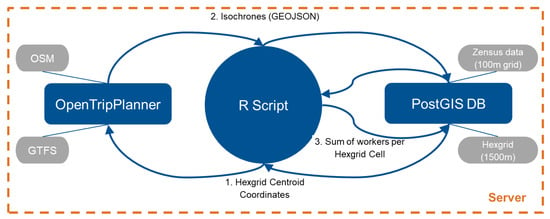
Figure 1.
Concept of the EMMA Accessibility Model.
After setting up the necessary software and data sources, a hexagon grid of the study area (width: 1500 m) is created (see Section 2.4.3 for details about this choice). This determines the spatial resolution of the modelling results. The hexagon grid is saved in the database, together with the census points. Using an R script, each grid centroid coordinates are sent to the OTP instance via the API, where an isochrone is calculated and returned to the script. In OTP, we can model multimodal isochrones (walking, cycling, driving, transit + walk) as well as intermodal travel in the form of various combinations of cycling and transit (bike and ride, ride and bike, bike—transit—bike, bike sharing).
The isochrones are created with a cutoff value of 30 min (see discussion in Section 2.4.1) with a specified arrival time at 9 a.m. at the workplace location. Optionally, we repeat the calculations for public transport (and intermodal combinations) in certain intervals for various arrival times (e.g., every 6 min between 8 a.m. and 9 a.m.) and merge the isochrones to reduce the impact of the timetable and headways. Using SQL in the PostGIS database, the number of potential workers within the isochrone is calculated and saved in the hexagon table, on the basis of a census grid with a 100 m resolution [44]. If a centroid yields an error (no isochrone found), the script moves the centroid by a random value between ± 750 m in both the x- and y-directions and tries again. That way, we minimize errors where the centroid is, e.g., located between two railway tracks and the routing algorithm is unable to produce an isochrone. This step is iterated three times in total to minimize this error while avoiding unnecessary calculations for hexagon cells that have a ‘null-isochrone’ because there is no street network leading to the cell.
The resulting hexagon grid with the accessible population is then visualized either as a web map (for example using the leaflet package in R) or exported and mapped via QGIS.
2.2. Data Sources
For the mobility-related components of the model, raw data from OpenStreetMap is downloaded in the compressed .osb.pbf format. The relevant data mainly include the street network for routing in OpenTripPlanner. Official and up-to-date information about public transport routes, stops, and schedules is obtained from the national open data portal DELFI in GTFS format [45].
Population data in the form of a 100 m grid are provided by the national census [44]. This fine level of detail fits well to our isochrone-based approach, where we can see in relative detail which of the 100 m cells provides access to our destination within 30 min. However, to speed up calculations, we reduced the square grid cells to the centroids, resulting in a 100 × 100 m point grid with population data. For further details on data preparation, see Appendix A.
2.3. Software and Technical Setup
All necessary software tools (OpenTripPlanner 1.4, PostGIS 12.4, R 4.03, RStudio Server 1.3) were installed on a VPS server running Ubuntu 18.04. OTP’s graph building function is used to combine the filtered GTFS data and the OSM network into a routable graph that is stored on the server as well (see [33]). All scripting and controlling of the model’s calculations are performed within the browser interface of RStudio Server.
2.4. Assumptions and Parameters
Several assumptions and parameters have an influence on the modelling results. The following paragraphs describe the reasoning behind our decisions.
2.4.1. Isochrone Generation
Isochrones are calculated for a 30 min trip duration for all modes. This is backed by actual travel behavior, since depending on the source, 50–70% of all trips to work in Germany (independent of modes) are shorter than 30 min [46,47,48]. Moreover, the goal of the accessibility analysis is not forecasting travel behavior but rather the assessment of the locations’ quality. Thus, the planning goal with this approach is to maximize the number of accessible workers within this threshold, given an optimization of both the transport system and land use.
The actual generation of the isochrones is performed by OpenTripPlanner. Using the API and the “isochrone” function, we send the centroid coordinates and the relevant parameters (such as 30 min cutoff and mode of transport) to OTP on the server. OTP is then, using its graph, based on the previously provided GTFS file and OSM street data in order to calculate the area from which it is possible to reach the grid centroid within the given travel time limit. The information is provided as a GeoJSON file by OTP, which is stored and further processed in the PostGIS database.
2.4.2. Temporal Parameters
Since the focus of the model is workplaces, a regular weekday (Wednesday) is selected for the calculations. Isochrones are calculated for a given arrival time at the workplace. For all timetable-based modes or intermodal combinations, we sample in 6 min intervals for an arrival between 08:00 and 09:00 a.m. Thereby, we minimize the error induced by unfavorable headways in relation to the arrival times. By using 6 min intervals instead of 5 or 10 min, we reduce the impact of randomly matching actual departure times. (e.g., if a bus departs at 07:02/12/22/…, our intervals at 07:06/12/18 deliver better results than 07:00/10/20/…). We also assume a certain flexibility in the desired arrival time within the given interval: If the fastest route from one home location to a workplace would result in an arrival at 08:15, for example, and another residential area would have the shortest travel time with an arrival at 08:45, we accept both trips as valid options. Thus, we calculate all isochrones according to this sampling and merge them to get the final isochrone for the hexagon centroid.
In the case of fixed-shift workplaces, however, this approach would not be fitting. On the other hand, most large workplaces with these work schedules have typically coordinated public transport services for these hours in Germany so that the proposed approach seems to be the most suitable.
2.4.3. Resulting Hexagon Grid
We suggest using a hexagon grid for the model results. This choice is based on two assumptions: (1) With hexagons, we can provide a comparable level of sampling detail with 30% less grid cells, compared to a usual squared grid [49]. Since the computing time of our model is proportional to the number of grid cells, this is a crucial factor. (2) Hexagon grids have the advantage that the distance from the center to the edges is more evenly distributed compared to squares. This is beneficial for the clarity of visualizations [50]. The grid width of 1500 m is a tradeoff between a high level of detail on the one hand, and acceptable computing times on the other hand. This grid results in 17,208 cells for the entire Munich Metropolitan Region. It is based on the idea that it provides roughly a 750 m average radius from the centroid, which is in public transport an acceptable walking distance from a station. Of course, this grid is only suitable for interpretation on a regional level. For detailed analysis of individual locations, a smaller level of detail is recommended in subsequent steps.
2.5. Comparison to Existing Approaches
Our proposed methodology has four main differences from existing approaches:
- Perspective: Most accessibility models in the realm of job and workplace accessibility apply the place-based perspective for residential locations, calculating access to jobs for workers [22,51,52,53]. Our approach, however, focuses on access to workers from the perspective of (potential) workplace locations. To date, only few operational models have applied this approach—mostly, within the context of ‘jobs–housing–balance’ approaches [54,55].
- Calculation method: Usually, spatial accessibility is calculated using origin destination matrices that contain travel times (or generalized costs) between all zones in the study area [30,49]. One disadvantage of this approach is that the computational effort required is exponential with respect to the number of zones. While it offers many opportunities for more complex analyses and is a prerequisite for gravity-based measures, the high computational burden may be a limitation in practice. Thus, focusing on simplicity, we apply a calculation based on isochrones around the zone centroids (see Section 2.4.1) that only requires one operation per cell. Moreover, this approach allows us to use the resulting isochrones both for quality checks and for communication of the results, which is especially useful when comparing scenarios.
- Multimodality and intermodality: In contrast to approaches that allow only the analysis of one mode of transport (often either automobile or public transport) [22], our model is capable of calculating accessibility in a multimodal and even intermodal way, on the basis of the features of OpenTripPlanner [33,56].
- Open Source and Open Data: As outlined in Section 2.1 and Section 2.2, all software, tools, and data sources used in this proposed approach are openly available. This makes our approach, depending on data availability, replicable anywhere and without any license costs. This is a major difference to approaches relying on commercial tools like ArcGIS Pro [22,30].
3. Results
In this section, we focus first on the result of our proposed modelling concept: Section 3 presents the resulting main maps and some findings about the computation performance. Later, in Section 4, we interpret the results and discuss their implications for the region.
The model was calculated for the entire study area and the following modes:
- Cycling;
- Public transport;
- Bike and ride;
- Driving.
Walking is technically possible but was excluded for the analysis on the regional scale.
Processing time for all modes, including OTP calculations and PostGIS operations, was around 12 h for the entire study area, consisting of 17,208 grid cells on a VPS Server with 8 GB RAM and an 8-core CPU.
Across all modes, the larger cities in the region Munich, Augsburg, Landshut, and Rosenheim are clearly identifiable by their higher accessibility compared to the less urban areas in between. Depending on the mode, this discrepancy between urban and rural is expressed in a different form.
Driving has the lowest differences between regions, with relatively high accessibility even in remote areas. The map (Figure 2) also shows quite a high number of cells with zero accessible population by car—this is explained by natural areas (lakes, forests, environmental protection areas), where driving is prohibited. In Munich, this is true in areas with large parks that are larger than the snapping distance to the closest network element. Driving reaches the highest number of accessible populations in the center of Munich, from which a large portion of the city is accessible within 30 min of driving. Along the region’s major highways, a higher accessibility was observed compared to adjacent areas.

Figure 2.
Thirty-minute accessibility by car.
The public transport map (Figure 3) reveals huge differences between urban and non-urban areas. In the centers of Munich and Augsburg, a relatively large area shows values comparable to driving, but with increasing distance to the centers, the accessibility decreases. Due to the organizational structure of public transport, we can see sharp drops in accessibility at the tariff systems’ boundaries. Also remarkable are the “island effects” around regional public transport lines such as the “S-Bahn” (commuter rail). However, these areas with relatively high accessibility are focused narrowly on areas around the stops, becoming smaller with longer travel times to the center. If we use the more detailed approach with arrival time intervals of 6 min between 8 and 9 a.m. as described earlier (Figure 4), we see higher values in general, but especially the areas around the urban areas profit.
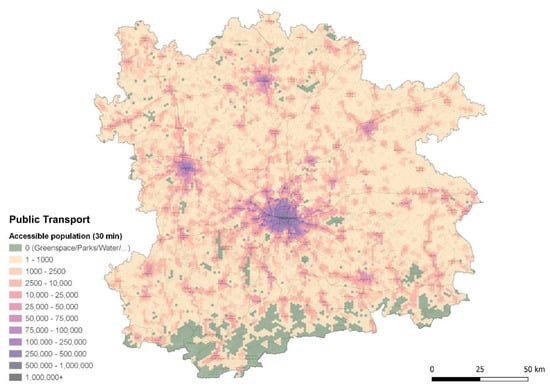
Figure 3.
Thirty-minute accessibility by public transport (arrival 09:00 a.m.).
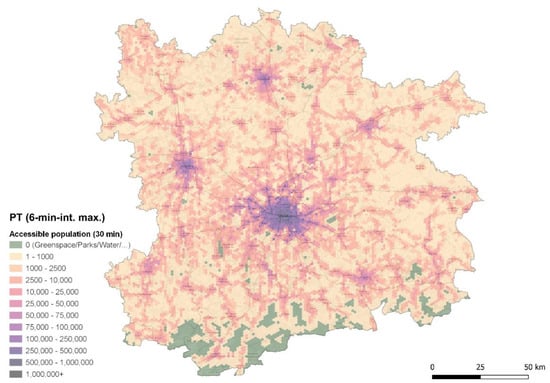
Figure 4.
Thirty-minute accessibility by public transport (max. between 8 and 9 a.m. in 6 min intervals).
In those areas, public transport connections to dense areas exist, but headways are low compared to the centers, and therefore sampling over multiple arrival times makes a large difference there. This effect is visualized in Figure 5, where we can see the ring around the City of Munich, where the impact is very high.
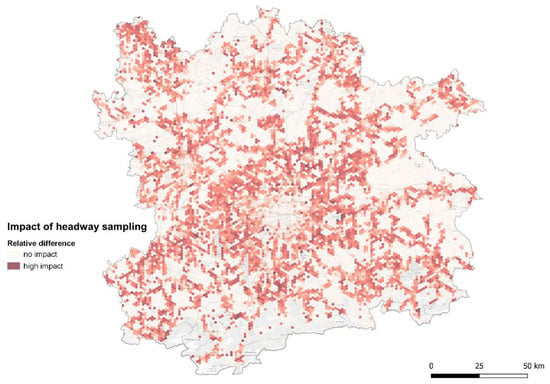
Figure 5.
Impact of arrival time interval sampling.
Accessibility by bicycle (Figure 6) provides the most evenly distributed results. The map shows that the values are again the highest in the centers of the urban areas and reduce with increasing distance to the centers, forming rings around the cities. In all urban areas, the values are in similar magnitudes as the private car, whereas in rural areas, due to lower densities, cycling yields relatively low accessibility in absolute numbers, compared to the other modes.
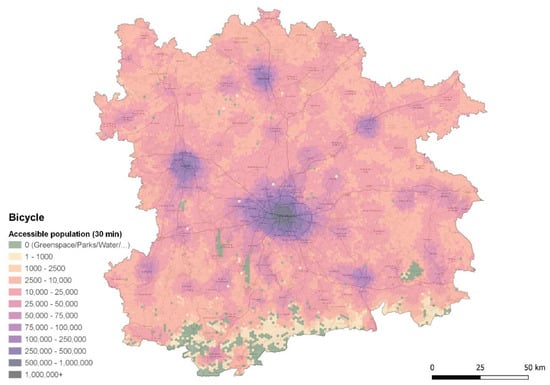
Figure 6.
Thirty-minute accessibility by bicycle.
Intermodal bike and ride accessibility shows very high accessibility in the centers and increases the size of the highly accessible central areas in the cities, but reveals lower accessibility than cycling alone in many rural areas. At the same time, the ‘islands’ around rail-based public transport stops are now larger than previously in the public transport analysis and have higher accessibility—something that is expected when cycling is essentially replacing the walking trip leg.
The resulting map (Figure 7) assumes that a bike must be used for the first trip leg. In some cases, e.g., in one-way streets, however, walking to the stop would be faster, since pedestrians can walk directly against the one-way direction to the stations whereas bicycles have to use the street in its designated direction and make a detour. Other examples such as pedestrian-only paths/zones, stairs, etc., produce the same effect. Moreover, in rural areas with long headways of one hour or more in bus networks, cycling could be an option to cycle to the next train station, but often this bike trip comes close to the 30 min cutoff value, whereas the bus (despite its low frequency) provides a much faster trip to the train, with huge accessibility gains compared to the forced first-leg bicycle trip. Thus, we argue for an indicator that selects the larger value from either bike and ride or walk and ride in order to assess an intermodal system of public transport and walking or cycling. This indicator is mapped in the following Figure 8 and presents higher values in rural areas with cycling times close to 30 min (or more) to the next rail-based public transport service.
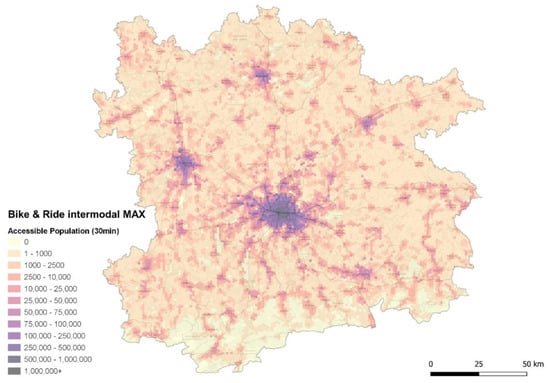
Figure 7.
Thirty-minute accessibility by bike and ride (intermodal).
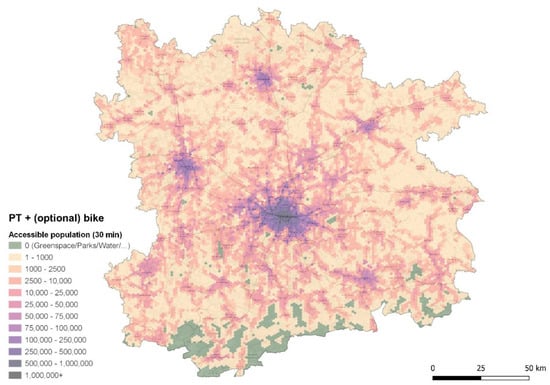
Figure 8.
Accessibility for maximum value of bike and ride or public transport.
4. Model Interpretation and Discussion of Results
After the technical analysis in Section 3, we now shift the focus to the implications we can derive from the modeling results and take also relative comparisons across the modes into account, which are better suited for interpretation. To obtain these, the values from the previously presented calculations were simply divided to create a percentage score.
4.1. Relative Accessibility—How Well Do Public Transport and Cycling Compare to the Private Car?
All assumptions on workplace accessibility are hypothetical per definition, since one job position does actually need one suitable person to be filled. It is important to note that the aim of this analysis was not to match actual workers with open positions, but to assess the quality of workplace locations in terms of their potential to be reached by workers. This takes into account both the mobility supply and the land use. With the aim of workplace locations that are car independent, it is a planning goal to minimize the need for a private car to get to work. Thus, a ‘good’ workplace location is accessible by multiple modes in a good way, and these alternatives to the private car provide comparable accessibility. Thus, an important indicator is the relative accessibility compared to driving. The first analysis shows cycling accessibility compared to driving (Figure 9):
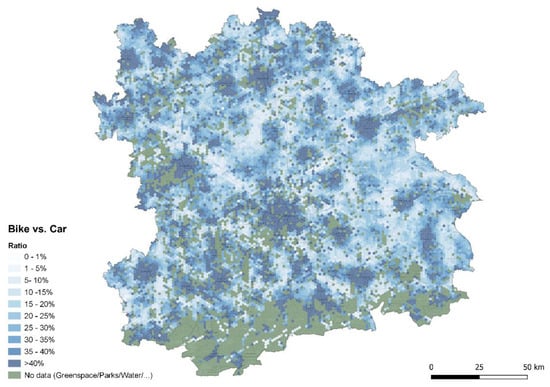
Figure 9.
Relative accessibility: bicycle vs. car.
In many cities, independent of the size, cycling reaches the highest category of >40% of the population accessible by driving. We see clear edges between these urban areas with a higher density and the rural areas in between. Important for the interpretation is that no quality of bicycle infrastructure plays a role in this analysis—the routing is based only on streets/paths where cycling is legal, independent of the type of bicycle infrastructure. The perception that cycling is a mode that has benefits in urban areas is confirmed, but it is important to understand that these urban areas do include also small cities in the region, not only Munich, Augsburg, and Ingolstadt. To make use of this accessibility potential, administrations need to provide safe and comfortable bike infrastructure. Employers can play a role in lobbying for this infrastructure and provide facilities for cyclists such as safe parking, lockers/showers, bad-weather backup services (such as taxi vouchers), or financial incentives for the purchase or leasing of bicycles or e-bikes.
Figure 10 shows a similar analysis for public transport in comparison to driving.
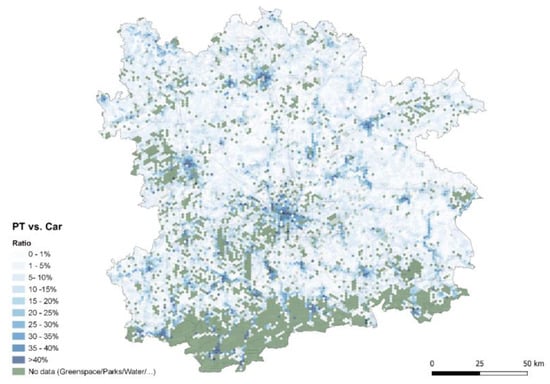
Figure 10.
Relative accessibility: public transport vs. car.
We found good PT accessibility again in the centers of the big four cities in the region. In the case of Munich, we see spikes especially for locations located at the central part of the commuter rail’s trunk line (‘Stammstrecke’). Moreover, many stops of rail-based public transport lines (local and regional) are visible, for example, the train from Munich to Rosenheim. Similar to the results for cycling vs. car, many small towns exhibit a strong accessibility by public transport as well, while we also know from mobility surveys that public transport plays a smaller role in the daily mobility of these residents compared to urban dwellers. While smaller towns in the regions do typically have a public transport network that covers the town and surrounding region quite well, they often lack high frequencies, direct routes, fast travel times, and alternative options in case of delays. These are factors that are not identifiable in the logic of the model but might well play a large role in the promotion of public transport on trips to work in these locations.
Another observation is the high relative accessibility in mountain areas in the south of the region. Whenever a town (such as Garmisch-Partenkirchen) is located in a valley, surrounded by mountains and connected by just one main access road, public transport can provide a viable alternative to private cars in terms of accessibility within 30 min. Even if most public transport stops are located on the main road, distances to potential destinations along the road are short. This effect is also visible in Lenggries, Tegernsee, Schliersee, and Mittenwald. Factors that are hindering this potential are congestion on the roads, which also affects buses; steep slopes for walking and cycling as access and egress mode to the stops; and harsh weather conditions in winter. Moreover, a lack of suitable options for trip chaining is an issue, along with reliability and punctuality problems.
4.2. Intermodality—Where Do Workplaces Benefit from Combining Public Transport and Cycling?
Intermodality, defined in our case as public transport combined with another mode such as cycling, has two main effects that can improve the accessibility of workplace locations:
- Increase in the accessible area (and thereby population) within a certain time threshold by faster first mile and/or last mile trip legs. This is the expected effect when walking is replaced by cycling, for example.
- Increase in the accessible area (and thereby population) within a certain time threshold by enabling new public transport routes that were not possible without the intermodal combination. For example, when stops can be reached by bike easily where the first public transport trip leg would be very slow.
The combination of both effects is visible in Figure 7, but also in the relative comparison when comparing bike and ride with driving (Figure 11).
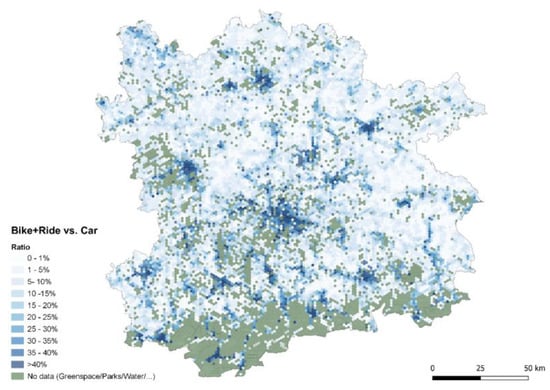
Figure 11.
Relative accessibility: bike and ride vs. car.
Overall, the mean of accessible workers for all grid cells across the region increased by 17.2% when using bike and ride instead of public transport only (Figure 12).
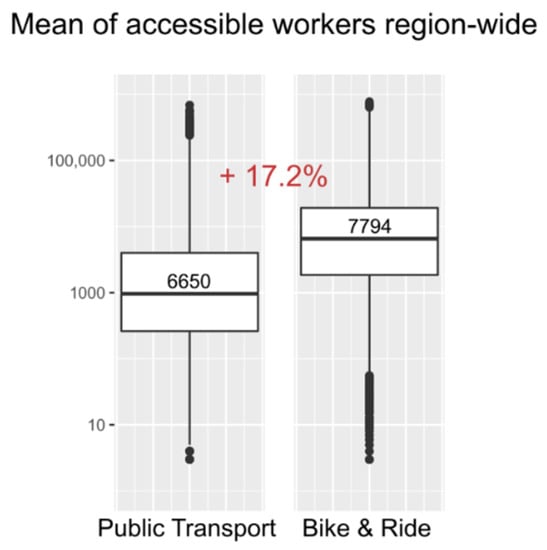
Figure 12.
Mean of accessible workers, PT vs. bike and ride (log scale).
Spatially, this increase was mainly found in the urban centers, but also along the rail axis in the region. The map in Figure 13 visualizes the areas with improvements in the accessibility by bike and ride in green.
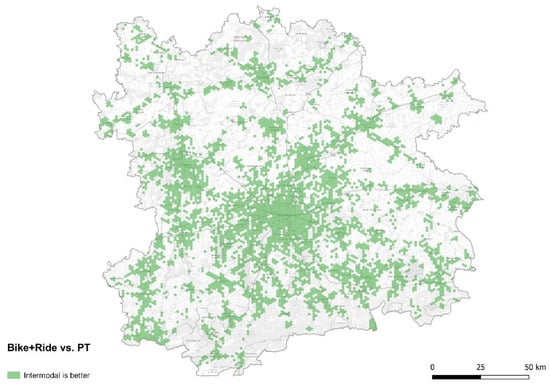
Figure 13.
In which cells does intermodality improve accessibility?
4.3. Score Transformation
In order to increase the interpretability of the model results, we propose a score transformation that scales the model result on a range from −100 to +100. Therefore, we used one of the fundamental indicators, the ratio of accessible workers by PT vs. car as a baseline, and transformed it into z-scores. In order to smooth out extreme values, the z-scores were capped at +/− 3 standard deviations. The result was then transformed into a range of −100 (lowest possible ratio PT vs. car in the observation area) to +100 (highest possible ratio). While this approach is very simple in its method, it helps to communicate and interpret the model results. Figure 14 shows the resulting map.
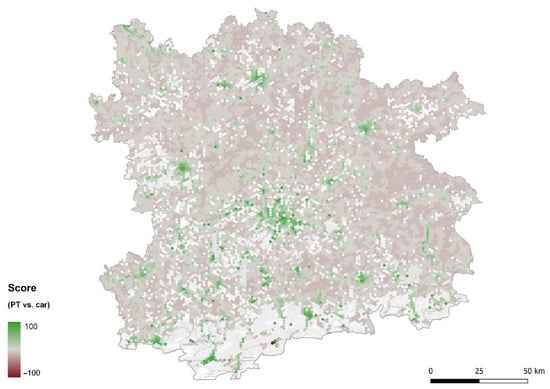
Figure 14.
Score of relative accessibility (PT vs. car).
In contrast to the relative visualization, where we present directly, e.g., the share of accessible population by public transport compared to private car, the score transformation allows for an interpretation that is independent of the actual values. A score of 0 represents a cell where the ratio is equal to the mean in the distribution of shares. Thus, the map shows in dark green the areas in the region that are among the best PT vs. car ratio, whereas the red areas are below the mean.
In this context, it is important to note that a score of −100 is never reached in this application. Instead, wide areas of the region are classified below median, which is in line with the observation that the public transport accessibility in the region spikes at certain centers, but is very low in wide areas of the region.
4.4. Role of Munich as the Most Accessible Area for Workplaces in the Region
Across all modes, Munich stands out as the area that can provide workplace locations with the highest accessibility. With a private car, the entire area within the outer motorway ring road provides a huge number of accessible residents within 30 min of driving. By public transport, we still see very high results for the entire functional urban region, and the same is true for cycling. At the same time, Munich is also the area in the region that already has the highest density and the lowest number of available areas for new workplace development. We can thus confirm the outstanding role within the region. Smaller-scale investigations will help identify optimization potentials on a smaller scale and be able to provide a more differentiated picture for areas of interest.
4.5. Polycentricity in the Region? The Role of the Other Centers
Especially in the cycling analysis, we do not only see the large cities in the region, but also small towns such as Freising, Weilheim, and Dachau show up with relatively good accessibility by bike (cf. Figure 6), whereas these cities report high driving rates to work in mobility surveys [40]. The explanation for this is based on the fact that these towns are typically compact (the entire area is accessible within 30 min of cycling from most starting points in the city) and have clear boundaries. They are surrounded by sparsely populated areas and, thus, the larger area that is reached by car does not result in huge accessibility gains due to a lack of population living there. Workplaces in these locations should provide a mixed use (shopping, childcare, post services, doctors, etc.) and proximity to the local centers to maximize this potential of short, non-motorized trips. If single-use workplace locations are developed in fringe areas of these towns with longer distances to the center, the probability that a car is needed for effective trip chaining is high. Bicycle infrastructure should be a priority in these compact sub-centers, and mobility management should emphasize the benefits of utilitarian cycling in these areas, where cycling is often seen as a mode of recreation and leisure activities.
5. Discussion
This work builds on the importance of workplace locations and their effects on daily mobility behavior such as mode choice, but also on long-term decisions such as car ownership or residential location choice. Accessibility analysis and accessibility modeling have previously shown a large amount of potential to improve the understanding of the qualities of locations of any kind, contributing to better decision making for municipalities, other regulatory bodies, or even companies. However, to date, there is no comprehensive methodology focused on multimodal and intermodal accessibility modeling for workplace locations that fulfills our defined criteria such as being open-source, transparent, flexible, and based on real-world data.
Therefore, we present a modeling concept based entirely on open-source components such as OpenTripPlanner, PostGIS, and R, allowing for efficient and fast accessibility analysis with a focus on workplace locations for entire regions on a grid-level and based on actual travel time isochrones for various modes (instead of the usually used OD matrices) and combinations of modes, with real-word public transport schedules.
Running the model for the entire Munich Metropolitan Region, we found the concept is capable of running large-scale accessibility analysis on moderate, consumer-grade hardware in an acceptable amount of time. The results show a coherent picture of the region, in line with expectations. With our maps, we argue for the use of relative indicators, such as public transport vs. car accessibility, in order to derive conclusions from the model. Moreover, a score transformation is advised in order to make results better understandable. In our analysis, Munich, but also other centers in the region such as Augsburg, stand out for their high competitiveness of non-car modes and intermodal combinations. However, also smaller cities, if they are relatively dense and compact, were shown to have a high potential to provide workplace locations that are not car dependent in the sense that a large number of potential workers can get there within 30 min without driving.
These results should be taken into account when considering various methods to apply accessibility modelling for workplace locations. Following the classification of [22], the EMMA model has the goal to evaluate the accessibility of (potential) workplace locations on a regional scale. It is thus a place-based model that includes various travel modes (multimodal and intermodal). The inherent function is a contour measure, operationalized through isochrones that count the number of people who can access the workplace in a given time threshold. Therefore, the data requirements are limited to OSM (street network), public transport schedules and stops (GTFS format), and population data. The model is thus one that focuses on simplicity both in operationalization and presentation of its results, in line with suggestions in the literature [21]. Its main distinction to usually applied methodologies is the focus on open-source software, which makes it transferable and replicable anywhere in the world, where the aforementioned data requirements are fulfilled. It builds on the existing frameworks and open source tools such as OpenTripPlanner [33], which was reviewed and compared by Higgins et al. [30], who determined it as a suitable tool for place-based analysis. Our approach that uses directly the isochrone output of OTP addresses a common limitation of OTP, which is the computation speed (and is greatly improved in newer tools like r5r [39]). The proposed EMMA model fulfills all criteria for a suitable accessibility model we derived in the introduction, which is a major contribution compared to the state of the art: it includes all relevant modes, including intermodal combinations, it is based on actual GTFS public transport schedules, it is open and transparent enough to allow adjustments in both land use and transport for the analysis of scenarios, it builds only on open-source tools, and our regional analysis runs within the required 12 h of computing time.
This helps us to validate our research hypothesis at least in part: The model shows potential to be used as a planning support instrument for regional planning of workplace locations. However, in order to determine whether it is actually ‘useful’ in comparison to existing tools, future research should include the feedback of practitioners in order to deliver a final conclusion on this hypothesis.
Of course, this analysis gives only a high-level overview of the region, and some limitations apply: A common problem of many accessibility models for workplace is the discrepancy between potential workers and actual workers. However, even though we do not have information about where the actual workers of a workplace reside, we can still assess the level of accessibility that is provided at the location and identify locations where the accessibility is high or low. Thus, we start from the land-use and transport system as a basis for future decision making of workers and firms, without trying to project their individual behavior.
Another limitation is the uniform cutoff value of 30 min travel time. It could be one option to increase the travel time for public transport compared to cars. This is commonly done in German regulations [57] and is based on observed mobility behavior. However, we assume that different time thresholds among the modes might be hard to understand in practice and thus we argue for the simpler approach with 30 min cutoff for all modes. This also applies for the use of more complex gravity-based measures instead of our isochrone-based approach.
For more detailed insights and especially for concrete recommendations for actual locations (or planned locations), a perspective beyond the grid level is necessary. However, our model sets the foundation for this since the isochrone-based approach can be applied to individual locations rather than grid cells as well. With the open and modifiable network data, this will allow us to analyze and compare scenarios in both land-use and mobility supply with this framework in the future.
Author Contributions
Conceptualization, M.P., B.B. and G.W.; methodology, M.P.; software, M.P.; writing—original draft preparation, M.P.; writing—review and editing, M.P., B.B. and G.W.; supervision, B.B. and G.W. All authors have read and agreed to the published version of the manuscript.
Funding
This work has been funded by the German Research Foundation (DFG), Project Number 401093473.
Institutional Review Board Statement
Not applicable.
Informed Consent Statement
Not applicable.
Data Availability Statement
Publicly available datasets were analyzed in this study. These data can be found here: Census 2011 Population data: https://www.zensus2011.de/DE/Home/Aktuelles/DemografischeGrunddaten.html;jsessionid=916003915C754E15594AD09E469F7130.live342?nn=559100 (accessed on 12 November 2022); Nationwide GTFS data: https://www.opendata-oepnv.de/ht/de/organisation/delfi/startseite?tx_vrrkit_view%5Bdataset_name%5D=deutschlandweite-sollfahrplandaten-gtfs&tx_vrrkit_view%5Baction%5D=details&tx_vrrkit_view%5Bcontroller%5D=View (accessed on 12 November 2022); Public OSM downloads: https://download.geofabrik.de/ (accessed on 12 November 2022).
Acknowledgments
This work is part of the DFG-funded research project “EMMA Empowering Multimodal and Intermodal Accessibility Analysis” and we would like to express our gratitude for the funding to work on this project. We would also like to express our gratitude to the project’s expert council (Daniel Krajzewicz, Alain L’Hostis, Rolf Moeckel, Klaus Nökel, Marcus Peter, Cecília Silva, and David Vale) for sharing their wisdom and discussing the project with us.
Conflicts of Interest
The authors declare no conflict of interest.
Appendix A. Data Preparation
Appendix A.1. Preparing GTFS Data
Since the public transport data are provided as a single GTFS dataset for all of Germany, a script to reduce the size of the data was developed. In R, the package ‘gtfsr’ [58] is used to import the entire dataset. Then, a bounding box is defined that will define the GTFS elements that will be retained in the filtering process. To avoid issues with broken line segments, this bounding box was defined with a buffer > 50 km to the boundaries of the study area, and the following steps were executed to filter the dataset:
- stops.txt: filter only those stops that are located within the bounding box (by latitude /longitude).
- stop_times.txt: filter only those features whose stop_id is also found in the filtered stops.txt dataset.
- trips.txt: filter only those features whose trip_id is also found in the filtered stop_times.txt dataset.
- routes.txt: filter only those features whose route_id is also found in the filtered trips.txt dataset.
Optionally and depending on the existence of these files in the raw data, the same process can be repeated with calendar_dates.txt, calendar.txt, and shapes.txt to decrease the file size even more. The result of the process is a filtered GTFS dataset (in .zip format) that includes only information on public transport stops, lines, and schedules that are relevant in the study area.
Appendix A.2. Preparing OSM Data
The OSM raw data in a compressed format can be downloaded, e.g., from Geofabrik [59]. After downloading the data for Bavaria, the file was cut to the identical bounding box used for the GTFS data with the help of osmconvert.exe [60].
To improve intermodal routing, the tag ‘amenity=bicycle_parking’ was added automatically to all rail-based public transport stops. OTP only allows bike parking at these designated locations, whereas in reality, it is usually possible to lock a bike near every rail-based public transport stop in Germany, independent of the infrastructure. This makes routes that include public transport and cycling more realistic but does not include capacity for bike parking.
This level of detail is sufficient for the regional analysis. For detailed analysis of locations, the actual bike parking facilities at public transport stops should play a role, however.
Appendix A.3. Preparing Census Data
Census data from 2011 is available for the whole of Germany in a 100 m grid [44]. The separate files with spatial information of the grid and population counts for each cell were imported into the spatial database. After cutting the grid to the previously mentioned bounding box to reduce the file size, a join operation was used to combine the remaining grid with population counts for each grid cell. Since we used a relatively high resolution, we reduced the grid cells to the centroids in PostGIS, and therefore the result of the preparation process is a point grid for the study area where each point indicates the population for the 100 × 100 m grid around the point. To speed up the calculation later, all points with no population were deleted.
References
- Brown, H.J. Changes in Workplace and Residential Locations. J. Am. Inst. Plan. 1975, 41, 32–39. [Google Scholar] [CrossRef]
- Naess, P.; Sandberg, S.L. Workplace Location, Modal Split and Energy Use for Commuting Trips. Urban Stud. 1996, 33, 557–580. [Google Scholar] [CrossRef]
- Simpson, W. Workplace Location, Residential Location, and Urban Commuting. Urban Stud. 1987, 24, 119–128. [Google Scholar] [CrossRef]
- Zhao, J. Knowledge Base Shapes Use of Space: Knowledge-Workers’ Interrelated Choices of Residence, Workplace and Commute in the Metropolitan Region of Munich. Ph.D. Thesis, Technische Universität München, München, Germany, 2017. [Google Scholar]
- Thierstein, A.; Wulfhorst, G.; Bentlage, M.; Klug, S.; Gilliard, L.; Ji, C.; Kinigadner, J.; Steiner, H.; Sterzer, L.; Wenner, F. WAM Wohnen Arbeiten Mobilität. Veränderungsdynamiken und Entwicklungsoptionen für die Metropolregion München; Project Report; Technische Universität München: München, Germany, 2016. [Google Scholar]
- Ding, C.; Wang, D.; Liu, C.; Zhang, Y.; Yang, J. Exploring the Influence of Built Environment on Travel Mode Choice Considering the Mediating Effects of Car Ownership and Travel Distance. Transp. Res. Part A Policy Pract. 2017, 100, 65–80. [Google Scholar] [CrossRef]
- Ding, C.; Cao, X. How Does the Built Environment at Residential and Work Locations Affect Car Ownership? An Application of Cross-Classified Multilevel Model. J. Transp. Geogr. 2019, 75, 37–45. [Google Scholar] [CrossRef]
- Pfertner, M.; Büttner, B.; Duran-Rodas, D.; Wulfhorst, G. Workplace Relocation and Its Association with Car Availability and Commuting Mode Choice. J. Transp. Geogr. 2022, 98, 103264. [Google Scholar] [CrossRef]
- Zarabi, Z.; Lord, S. Toward More Sustainable Behavior: A Systematic Review of the Impacts of Involuntary Workplace Relocation on Travel Mode Choice. J. Plan. Lit. 2019, 34, 38–58. [Google Scholar] [CrossRef]
- Vale, D.S.; Pereira, M.; Viana, C.M. Different Destination, Different Commuting Pattern? Analyzing the Influence of the Campus Location on Commuting. J. Transp. Land Use 2018, 11, 1–18. [Google Scholar] [CrossRef]
- Hansen, W.G. How Accessibility Shapes Land Use. J. Am. Inst. Plan. 1959, 25, 73–76. [Google Scholar] [CrossRef]
- Geurs, K.T.; van Wee, B. Accessibility Evaluation of Land-Use and Transport Strategies: Review and Research Directions. J. Transp. Geogr. 2004, 12, 127–140. [Google Scholar] [CrossRef]
- Bruinsma, F.R.; Rietveld, P. The Accessibility of European Cities: Theoretical Framework and Comparison Approaches. Env. Plann 1998, 30, 449–521. [Google Scholar] [CrossRef]
- Reggiani, A. Accessibility, Trade and Location Behaviour: An Introduction. In Accessibility, Trade and Location Behaviour. Ashgate, Aldershot; Reggiani, A., Ed.; Routledge: Abingdon-on-Thames, UK, 1998; pp. 1–16. [Google Scholar]
- Vickerman, R.W. The Regional Impacts of Trans-European Networks. Ann. Reg. Sci. 1995, 29, 237–254. [Google Scholar] [CrossRef]
- Morris, J.M.; Dumble, P.L.; Wigan, M.R. Accessibility indicators for transport planning. Transp. Res. A 1979, 13, 91–109. [Google Scholar] [CrossRef]
- Bertolini, L.; le Clercq, F.; Kapoen, L. Sustainable Accessibility: A Conceptual Framework to Integrate Transport and Land Use Plan-Making. Two Test-Applications in the Netherlands and a Reflection on the Way Forward. Transp. Policy 2005, 12, 207–220. [Google Scholar] [CrossRef]
- META-Accessibility. Available online: https://www.accessibilityplanning.eu// (accessed on 8 June 2022).
- Papa, E.; Silva, C.; Te Brömmelstroet, M.; Hull, A. Accessibility Instruments for Planning Practice: A Review of European Experiences. J. Transp. Land Use 2015, 9, 57–75. [Google Scholar] [CrossRef]
- Silva, C.; Bertolini, L.; te Brömmelstroet, M.; Milakis, D.; Papa, E. Accessibility Instruments in Planning Practice: Bridging the Implementation Gap. Transp. Policy 2017, 53, 135–145. [Google Scholar] [CrossRef]
- Silva, C.; Pinto, N.; Bertolini, L. Designing Accessibility Instruments: Lessons on Their Usability for Integrated Land Use and Transport Planning Practices; Routledge: Abingdon-on-Thames, UK, 2019. [Google Scholar]
- Siddiq, F.; Taylor, B.D. Tools of the Trade?: Assessing the Progress of Accessibility Measures for Planning Practice. J. Am. Plan. Assoc. 2021, 87, 497–511. [Google Scholar] [CrossRef]
- Malekzadeh, A.; Chung, E. A Review of Transit Accessibility Models: Challenges in Developing Transit Accessibility Models. Int. J. Sustain. Transp. 2020, 14, 733–748. [Google Scholar] [CrossRef]
- Bhat, C.; Handy, S.; Kockelman, K.; Mahmassani, H.; Chen, Q.; Weston, L. Development of an Urban Accessibility Index: Literature Review. 2000. Available online: https://rosap.ntl.bts.gov/view/dot/14882 (accessed on 3 August 2022).
- Wu, H.; Levinson, D. Unifying Access. Transp. Res. Part D Transp. Environ. 2020, 83, 102355. [Google Scholar] [CrossRef]
- Páez, A.; Scott, D.M.; Morency, C. Measuring Accessibility: Positive and Normative Implementations of Various Accessibility Indicators. J. Transp. Geogr. 2012, 25, 141–153. [Google Scholar] [CrossRef]
- Peter, M. Die Berechnung Kleinräumiger Und Multimodaler Erreichbarkeiten Auf Regionaler Ebene. Ph.D. Thesis, Technische Universität Hamburg, Hamburg, Germany, 2021. [Google Scholar]
- Reggiani, A.; Martín, J.C. Guest Editorial: New Frontiers in Accessibility Modelling: An Introduction. Netw. Spat. Econ. 2011, 11, 577–580. [Google Scholar] [CrossRef]
- Pajares, E.; Büttner, B.; Jehle, U.; Nichols, A.; Wulfhorst, G. Accessibility by Proximity: Addressing the Lack of Interactive Accessibility Instruments for Active Mobility. J. Transp. Geogr. 2021, 93, 103080. [Google Scholar] [CrossRef]
- Higgins, C.; Palm, M.; DeJohn, A.; Xi, L.; Vaughan, J.; Farber, S.; Widener, M.; Miller, E. Calculating Place-Based Transit Accessibility: Methods, Tools and Algorithmic Dependence. J. Transp. Land Use 2022, 15, 95–116. [Google Scholar] [CrossRef]
- Weiss, L.; Schwillinsky, S.; Castellazzi, B.; Prinz, T. Erreichbarkeitsmodell Österreich- Ein Werkzeug Zur Österreichweiten Analyse Der Versorgung Mit MIV Und ÖV. J. Angew. Geoinformatik 2018, 235–240. [Google Scholar]
- Stein, N. Accessibility as a Precondition for Sustainable Development. In Industry, Innovation and Infrastructure; Leal Filho, W., Azul, A.M., Brandli, L., Özuyar, P.G., Wall, T., Eds.; Encyclopedia of the UN Sustainable Development Goals; Springer International Publishing: Cham, Switzerland, 2019; pp. 1–10. ISBN 978-3-319-71059-4. [Google Scholar]
- Young, M. OpenTripPlanner-Creating and Querying Your Own Multi-Modal Route Planner. 2019. Available online: https://www.researchgate.net/profile/Marcus-Young-7/publication/321110774_OpenTripPlanner_-_creating_and_querying_your_own_multi-modal_route_planner/links/5c9bc34a299bf111694bbfdf/OpenTripPlanner-creating-and-querying-your-own-multi-modal-route-planner.pdf (accessed on 8 June 2022).
- Conveyal R5 Routing Engine 2022. Available online: https://github.com/conveyal/r5 (accessed on 8 June 2022).
- Conway, M.W.; Byrd, A.; van der Linden, M. Evidence-Based Transit and Land Use Sketch Planning Using Interactive Accessibility Methods on Combined Schedule and Headway-Based Networks. Transp. Res. Rec. 2017, 2653, 45–53. [Google Scholar] [CrossRef]
- Conway, M.W.; Byrd, A.; Eggermond, M. van Accounting for Uncertainty and Variation in Accessibility Metrics for Public Transport Sketch Planning. J. Transp. Land Use 2018, 11, 541–558. [Google Scholar] [CrossRef]
- Conway, M.W.; Stewart, A.F. Getting Charlie off the MTA: A Multiobjective Optimization Method to Account for Cost Constraints in Public Transit Accessibility Metrics. Int. J. Geogr. Inf. Sci. 2019, 33, 1759–1787. [Google Scholar] [CrossRef]
- Morgan, M.; Young, M.; Lovelace, R.; Hama, L. OpenTripPlanner for R. J. Open Source Softw. 2019, 4, 1926. [Google Scholar] [CrossRef]
- Pereira, R.H.; Saraiva, M.; Herszenhut, D.; Braga, C.K.V.; Conway, M.W. R5r: Rapid Realistic Routing on Multimodal Transport Networks with r 5 in r. Findings 2021, 21262. [Google Scholar] [CrossRef]
- Nobis, C.; Kuhnimhof, T. Mobilität in Deutschland-MiD: Ergebnisbericht. 2018. Available online: https://elib.dlr.de/125879/ (accessed on 8 June 2022).
- Drees & Sommer. Bericht zur Vernetzungsstudie Mobilität in der Metropolregion München; Drees & Sommer: Stuttgart, Germany, 2018. [Google Scholar]
- Chan, K.; Farber, S. Factors Underlying the Connections between Active Transportation and Public Transit at Commuter Rail in the Greater Toronto and Hamilton Area. Transportation 2020, 47, 2157–2178. [Google Scholar] [CrossRef]
- Silva, C. Structural Accessibility for Mobility Management. Prog. Plan. 2013, 81, 1–49. [Google Scholar] [CrossRef]
- ZENSUS 2011. Available online: https://www.zensus2011.de/DE/Home/home_node.html (accessed on 8 June 2022).
- Datensätze-OpenData ÖPNV. Available online: https://www.opendata-oepnv.de/ht/de/datensaetze?tx_vrrkit_dataset[action]=dataset&tx_vrrkit_dataset[controller]=View&tx_vrrkit_dataset[filter]=soll-fahrplandaten&tx_vrrkit_dataset[key]=group&cHash=af1647ddeaf44d25698589621b1f59f6 (accessed on 8 June 2022).
- ADAC Pendeln mit dem Auto ist oft Noch Alternativlos. Available online: https://www.adac.de/verkehr/verkehrssicherheit/unterwegs/pendler/ (accessed on 8 June 2022).
- Statista Pendeldauer in Deutschland 2022. Available online: https://de-statista-com/prognosen/999778/deutschland-dauer-des-taeglichen-pendelns (accessed on 8 June 2022).
- Statistisches Bundesamt Berufspendler. Available online: https://www.destatis.de/DE/Themen/Arbeit/Arbeitsmarkt/Erwerbstaetigkeit/Tabellen/pendler1.html (accessed on 8 June 2022).
- Burdziej, J. Using hexagonal grids and network analysis for spatial accessibility assessment in urban environments—A case study of public amenities in Toruń. Misc. Geogr. 2019, 23, 99–110. [Google Scholar] [CrossRef]
- Shoman, W.; Demirel, H. A Comparative Spatial Analysis on Land-Use Clusters for Accessibility; AGILE: Wageningen, The Netherlands, 2017. [Google Scholar]
- Pritchard, J.P.; Tomasiello, D.; Giannotti, M.; Geurs, K. An International Comparison of Equity in Accessibility to Jobs: London, São Paulo, and the Randstad. Transp. Find. 2019, 7942. [Google Scholar] [CrossRef] [PubMed]
- Grisé, E.; Boisjoly, G.; Maguire, M.; El-Geneidy, A. Elevating Access: Comparing Accessibility to Jobs by Public Transport for Individuals with and without a Physical Disability. Transp. Res. Part A Policy Pract. 2019, 125, 280–293. [Google Scholar] [CrossRef]
- Hu, Y.; Downs, J. Measuring and Visualizing Place-Based Space-Time Job Accessibility. J. Transp. Geogr. 2019, 74, 278–288. [Google Scholar] [CrossRef]
- Deboosere, R.; El-Geneidy, A.M.; Levinson, D. Accessibility-Oriented Development. J. Transp. Geogr. 2018, 70, 11–20. [Google Scholar] [CrossRef]
- Levinson, D.; Marion, B.; Owen, A.; Cui, M. The City Is Flatter: Changing Patterns of Job and Labor Access. Cities 2017, 60, 124–138. [Google Scholar] [CrossRef]
- OpenTripPlanner. Available online: https://www.opentripplanner.org/ (accessed on 7 January 2023).
- Forschungsgesellschaft für Straßen-und Verkehrswesen. Richtlinien für Integrierte Netzgestaltung RIN; Ausgabe 2008; FGSV-Verl.: Köln, Germany, 2009; ISBN 3-939715-79-4. [Google Scholar]
- McVey, E.; Noriega-Goodwin, D. Gtfsr: Working with GTFS (General Transit Feed Specification) Feeds in R; 2021. [Google Scholar]
- Geofabrik Geofabrik Download Server. Available online: https://download.geofabrik.de/ (accessed on 4 February 2022).
- Weber, M. Osmconvert. Available online: https://wiki.openstreetmap.org/wiki/Osmconvert (accessed on 8 June 2022).
Disclaimer/Publisher’s Note: The statements, opinions and data contained in all publications are solely those of the individual author(s) and contributor(s) and not of MDPI and/or the editor(s). MDPI and/or the editor(s) disclaim responsibility for any injury to people or property resulting from any ideas, methods, instructions or products referred to in the content. |
© 2023 by the authors. Licensee MDPI, Basel, Switzerland. This article is an open access article distributed under the terms and conditions of the Creative Commons Attribution (CC BY) license (https://creativecommons.org/licenses/by/4.0/).